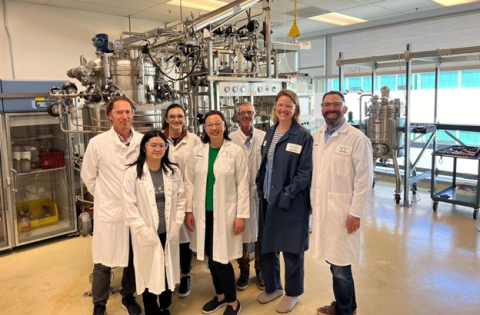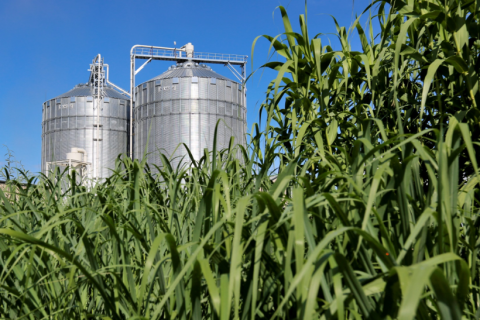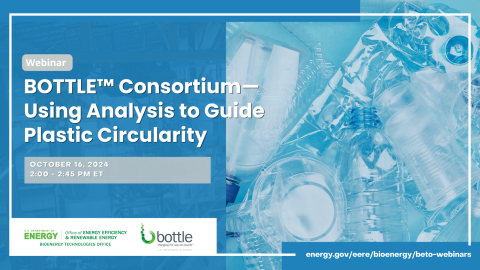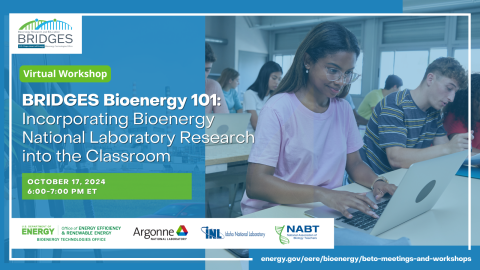RSS











Researchers at the U.S. Department of Energy’s Bioenergy Technologies Office (BETO) funded Agile BioFoundry (ABF) and the Advanced Biofuels and Bioproducts Process Development Unit (ABPDU), have successfully scaled up a bio-based process that converts ethanol into a valuable precursor for consumer products, such as paints, coatings, and diapers. The researchers worked with industry partner, Industrial Microbes, to develop the technology.

A multi-country, government-led initiative dedicated to advancing the global transition to a bio-based economy, unveiled a new Global Biomass Resource Assessment, providing groundbreaking data on current and future biomass supplies around the world.

The U.S. aviation sector, responsible for around 2% of the nation’s annual carbon emissions, is a key target for emissions reduction—but there are many technical and logistical hurdles remaining when conceptualizing an efficient, scaled future for the production and use of sustainable aviation fuels (SAF).

Join the U.S. Department of Energy’s (DOE’s) Bio-Optimized Technologies to keep Thermoplastics out of Landfills and the Environment (BOTTLE™️) consortium on Oct. 16, 2024, 2–2:45 p.m. ET, for a webinar titled, A Primer on Using Analysis to Guide Plastic Circularity.

Tune in to PBS’s newest season of Energy Switch! U.S. Department of Energy (DOE) Bioenergy Technologies Office (BETO) Director, Dr. Valerie Sarisky-Reed, will be interviewed on Energy Switch’s upcoming season to discuss the importance of biofuels to the U.S. bioeconomy and the progress that has been made to support energy innovation and research.

The Bioenergy Research and Education Bridge Program (BRIDGES) is partnering with the National Association of Biology Teachers (NABT) to host the BRIDGES Bioenergy 101 Virtual Workshop from 6 p.m. to 7 p.m. ET on Thursday, Oct. 17, 2024. Educators will be introduced to bioenergy national laboratory research that can be integrated into classrooms. Bioenergy knowledge is not required.

National Renewable Energy Laboratory (NREL) scientists engineered a process for making β-ketoadipic acid from lignin for $2 per kilogram, approaching cost-competitiveness with petroleum-based chemicals used for making nylon today. With support from the U.S. Department of Energy Bioenergy Technologies Office, researchers are a step closer to addressing one possible answer to the persistent question of lignin.

The U.S. Department of Energy (DOE) Office of Technology Transitions (OTT) announced their Notice of Intent (NOI) to issue a call for proposals from DOE National Laboratories, Plants, and Sites for the Fiscal Year (FY) 2025 Core Laboratory Infrastructure for Market Readiness (CLIMR) Lab Call. The goal of OTT's Technology Commercialization Fund (TCF) is to improve America’s energy competitiveness and security by accelerating commercialization of critical energy technologies to market. DOE anticipates releasing the FY25 CLIMR Lab Call in October 2024.
Today, an interagency team led by the U.S. Department of Energy (DOE), U.S. Department of Agriculture (USDA), and U.S. Department of Transportation’s (DOT’s) Federal Aviation Administration (FAA) released the Sustainable Aviation Fuel (SAF) Grand Challenge: Tracking Metrics and Mid-2024 Dashboard. USDA Secretary Thomas Vilsack made the announcement at the North American SAF Conference in St. Paul, Minnesota. The Metrics Dashboard summarizes actions and progress to help drive innovation and expand the production and use of SAF to meet the Grand Challenge target of 3 billion gallons of SAF in the United States by 2030.

Emerging bioenergy technologies are transforming the foundation of our lives, everything from clothing to plastics to fuels. Through biotechnology and biomanufacturing, biomass across the United States can be converted into new materials and provide an alternative to petroleum-based production for fuels and products. The U.S. Department of Energy’s (DOE’s) Bioenergy Technologies Office (BETO) is doing its part to strengthen America’s bioeconomy and supply chain to support energy innovation.

